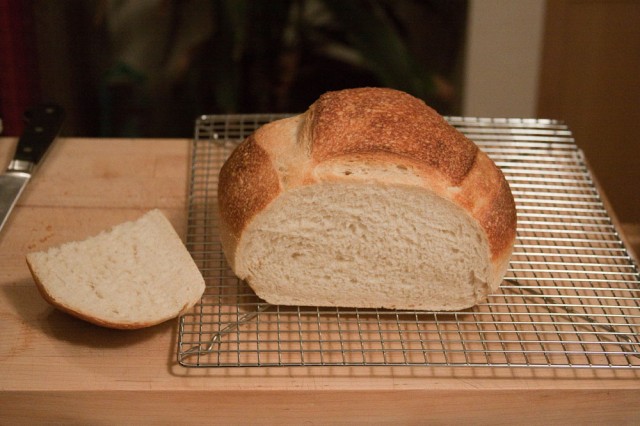Since my last post, I received the book Bread Science in the mail, and I’ve baked two loaves of sourdough.
Loaf No. 6 was crap. I didn’t bother taking any photos of it.
Loaf No. 7 was perfect in my eyes and in my mouth.
The day that I received the book, I devoured it. I was a bit disappointed with it. There’s a lot of science but half of it doesn’t translate through to actually baking at home. On the other hand, I was able to read between the lines and figure out what I’ve been doing wrong. So, all in all, the book helped in spite of its holes. Here’s what I’ve learned.
As I wrote in the previous post, my first mistake was not using a flour with a high enough protein content. This I learned before I got the book.
My doughs have been too dry. I tend to add flour during the kneading process to make it non-sticky. Sourdoughs seem more sticky than other doughs I’ve worked with. Water and salt are needed to make the gluten form. In looking at the photos in the book, the author’s dough was pretty wet looking. She wrote about sometimes needing a dough scraper to get the dough off of the board.
The “window” test is where you stretch the dough into a thin membrane and can see light through it. I’ve known about the window test, but never successfully got a window. Between the low protein flour and the dough being too dry, the window would always break.
Today I left a lot more moisture in the dough and kneaded it while it was sticking to everything. I don’t know how much of difference this makes, but the author doesn’t add the salt until the kneading stage. Today I did that as well. And I got a good window!
One thing I’ve always lacked is “oven spring”. This is when the dough expands in the oven. Mine has never expanded. It always stayed the same size as when it went into the oven. I’ve tried steam and other remedies to no avail. I think the primary reasons are what I’ve mentioned before.
One thing I learned from Loaf No. 6, is that the author’s oven temperature is way too high for 8300 feet elevation, even with steaming.
For Loaf No. 7, I had a large roasting pan sitting on the bottom of the oven, with about 1/4 inch of water in it. I also spritzed the dough with water from a spray bottle before sticking it into the oven. To get oven spring, you need to keep that outer layer of dough soft enough so it can expand. This all happens in the first 10-15 minutes of baking. Water, water, water! It’s the elevation because water evaporates so easily.
After 15 minutes I pulled the roasting pan out and let the bread continue baking another 20 minutes (total of 35 minutes for the boule). My oven was at 375. I checked the internal temperature of the bread at 30 minutes and it was 170. It should be around 180 or higher. So, I let it go another 5 minutes.
At this elevation, water boils at 190. I’m thinking if internal temperature of the bread is over 190, the bread is overcooked and dried out.
This bread is so good, there’s nothing I need to improve. And now that I have much better handle on the dough moisture while kneading, it will be much easier to make in the future.
Sourdough bread takes a long time, but not much work. I let it ferment for about 6 hours after kneading, punching down once. Then let it rise for two hours once it was in the pie pan. This sourdough starter seems to make more alcohol than CO2. That was probably good because the dough kept moist during all that time.
Edited to add: I just realized that Loaf No. 7 is actually Loaf No. 6. I counted wrong. But I’m not changing it. Seven is lucky after all.


